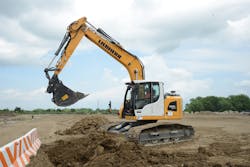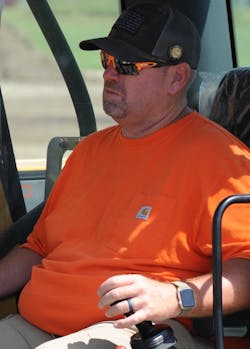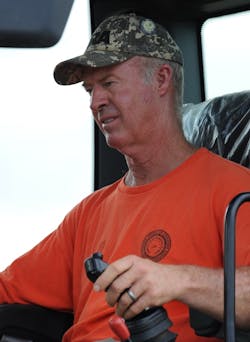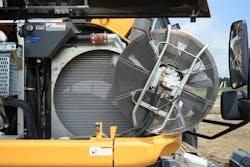Liebherr R 920 Excavator Proves Proficient
Whatever term you might use to describe them—“compact,” “close-radius,” or “reduced-tail-swing”—hydraulic excavators designed to limit the distance the upper structure extends over the tracks at 90 degrees are becoming increasingly popular, especially among buyers who must be mindful of the machine’s working envelope.
When these machines first appeared, prospective buyers questioned whether digging and lifting performance would be compromised (what with far less machine hanging out the back to serve as counterweight) and whether operator cabins would be smaller (maybe even uncomfortably so) to accommodate the upper’s shortened dimensions. For the most part, excavator manufacturers have solved those potential shortcomings. The Liebherr R 920 LC Compact Litronic illustrated that point during a recent Construction Equipment field test.
Working with Liebherr USA’s Construction Equipment Division, Finkbiner Equipment Co. (Liebherr’s dealer based in Burr Ridge, Ill.), and IUOE Local 150 in Wilmington, Ill., CE had opportunity for a close look at the R 920’s design and performance as Local 150 operators Greg Frieders and Hershel Howard, instructors for the Local’s Apprenticeship and Skill Improvement Program (ASIP), spent the better part of a hot, humid June day working the machine at various tasks.
The site for the evaluation was Local 150’s 300-acre ASIP training facility. In attendance from Liebherr was Mike Brooks, district service rep, and from Finkbiner, Jason Zeibert, president; Don Fitzgerald, product support manager; and Jerry Joynt, equipment sales.
Watch a video report below.
Basic specs and choices
The R 920 uses a 150-horsepower (ISO 9249) Liebherr engine and has an operating weight that varies from approximately 41,000 to 48,000 pounds—depending on undercarriage and front-linkage choices and whether fitted with an optional blade, the latter adding about 3,500 pounds.
The machine’s hydraulic pumps, hydraulic motors, and cylinders are of Liebherr design and manufacture, as is the available Likufix coupler, which eliminates the need for internal hoses by using integral hydraulic-oil passages. A universal coupler, in either mechanical or hydraulic configuration, is also available.
The R 920’s engine uses only a diesel oxidation catalyst and a selective-catalytic-reduction system to control emissions: “no diesel particulate filter to service,” said Zeibert, as he pointed out the R 920’s design features during an initial walk-around, “and no exhaust-gas-recirculation system pumping combustion byproducts back into the cylinders.”
The machine on site was equipped with the R 920’s wide-gauge undercarriage (7 feet 5 inches), 30-inch track shoes, mono boom (16 feet 5 inches), longest available stick (8 feet 8 inches), Werk-Brau hydraulic coupler, 1.03-cubic-yard bucket with spade teeth, and the optional blade. Available are a narrow-gauge undercarriage (6 feet 7 inches); three optional booms: mono-offset, two-piece, and two-piece-offset; and two additional sticks: 7-foot 5-inch and 8-foot.
The walk-around completed, Frieders and Howard then used the R 920 in a number of typical job-site applications: trenching, truck-loading, lifting, front-shovel work, and perhaps in a not-so-typical task for an excavator, dozing considerable volumes of excavated material back into the trenches.
R 920 blade kudos
The R 920’s blade, in fact, was among the operators’ favorite features.
“I was impressed with the size and heavy-duty design of the blade,” said Howard. “The cylinders are well protected, and it has a lot of lift height—probably a foot higher than the blade on a similar size competitive excavator I ran for quite a while. [Blade travel is 27 inches above and 25 inches below grade.]
“With that much lift height, the machine can negotiate obstacles that would otherwise hang up the blade, and its pushing power is excellent, even when turning. The soil here is a tacky clay that can slow a track excavator when it turns, but the 920 has the power to turn and keep a full load on the blade without losing speed. Most of time I had material boiling over the top of the blade.”
Frieders agreed. “This machine has superior pushing power for handling the blade, and the blade controls are excellent, with the mini-joystick on top of the main joystick. Most machines use a separate lever for the blade, but on the 920, you can control the blade without taking your hand off the joystick. It’s a good design.”
(The “mini-joystick” Frieders referenced is a small, electro-hydraulic, two-axis controller that is positioned at the top of both pilot-controlled joysticks and used for auxiliary functions.)
“My only thought is that an angle function on the blade would be useful, provided you could add that function without detracting in any way from the blade’s present capability,” said Frieders. “With a multifunction blade like that, the 920 might be able to take a machine out of the picture on some sites.”
“The way the controls are set up,” said Howard, “I think you could almost do finish work with the blade. And as Greg said, depending on the job, the 920 could potentially replace a small dozer on some sites.”
Lifting stability
The operators were equally impressed with the R 920’s lifting ability—and its stability when doing so—as they handled an 8,300-pound crane counterweight and 10-foot-long concrete traffic barriers.
“It’s a very stable machine—it has a good footprint,” said Frieders. “We took that counterweight out to full reach over the side, and the machine was very stable, very smooth. The only time it showed any hint of getting a bit light was when I purposely gave the stick a quick twitch outward just to see how the machine would react. But as long as you kept movements smooth, there was absolutely no problem. The machine’s sensitive mode is an advantage when you’re lifting—it slows down hydraulic action for better control, but you’re not losing any power.”
The R 920 has four operating modes: Sensitive; ECO; Power; and Power Plus. “It’s the only excavator I’ve run that doesn’t seem to lose power in its ECO mode,” said Frieders.
“The sensitive mode was a plus when handling the barriers,” said Howard. “It’s an application where you really need smooth hydraulic response and ample hydraulic power. That mode would be helpful as well on sewer jobs, where you might be spreading stone or handling trench boxes. The machine has a lot of breakout force.”
Brooks made the point that Liebherr excavators benefit from the company’s long experience in the crane industry. The R 920, he told us, has standard safety check valves (burst-protection valves) in both the boom and stick circuits, and a load-holding valve for the bucket circuit is an option. Also reflecting the company’s crane expertise, he said, is an optional overload-warning system, as well as systems that limit boom travel (advantageous in low-overhead situations, he said) and that limit stick travel (preventing contact with the cab, especially when large buckets are used).
Excavating
Both operators agreed that the stability, hydraulic power, and controllability the R 920 demonstrated in lifting exercises also served well when the machine was involved with dirt work: trenching, truck-loading, and doing front-shovel work.
“I was impressed with the machine’s power,” said Howard. “The settings—power and power-plus—made the machine easy to handle, and I thought the speed of hydraulic response was very good.”
Frieders agreed, but did have a suggestion for Liebherr.
“I’d like to see the dipper a bit faster,” he said, “but then again, every machine has its quirks, and you have to get used to how it functions. I’m not saying that the Liebherr is slower than any other machine—it just reacts in its own way.
“Overall, I’d rate its digging performance as excellent. The pilot controls on this machine are very smooth and responsive, but have a bit of a different touch, compared with electro-hydraulic controls. It’s just a matter of initially adapting to the individual system when you first use the machine.”
The operators said that the R 920 also was adept and powerful when handling the bucket in a front-shovel configuration.
“The machine had plenty of power with the shovel,” said Frieders. “We were able to excavate aggressively in an area that had not been disturbed for a long time and fill the bucket completely. On some machines, digging with the bucket in the shovel position can be difficult.”
Operator environment
When asked about any cab features they particularly liked, both operators mentioned what might seem a relatively insignificant item—but obviously important from an experienced operator’s point of view.
“Being able to take the bottom front window, attach it to the top window, and store the entire assembly overhead is, for me, a key feature,” said Frieders.
Howard agreed.
“On most machines, you have to remove the bottom window and store it somewhere in the cab. Usually it’s not secured very tightly in its holder, and it’s always vibrating.”
The R 920’s operating environment received generally high marks.
“It’s a very comfortable machine,” said Frieders. “Controls are well positioned, visibility is excellent, air-ride seat is comfortable, consoles are adjustable, and there’s plenty of leg room for a tall guy—it’s a very operator-friendly machine.”
Howard emphasized the R 920’s visibility.
“The combination of mirrors and cameras basically lets you see all around the machine. You can bring up a split screen for the cameras at the back and on the right side. It’s a very functional cab.”
And, both operators again mentioned the design of the R 920’s joystick controllers, which incorporate the top-mounted mini joysticks.
“The fact that you don’t have to take your hands off the joysticks to use a separate controller for an auxiliary function is a plus for this machine,” said Frieders. “The design just seems more functional than some others.”
Howard summed up the overall impression of the R 920 after he and Frieders spent the better part of a day at the controls.
“It’s a smooth, quiet, well-balanced machine.”





